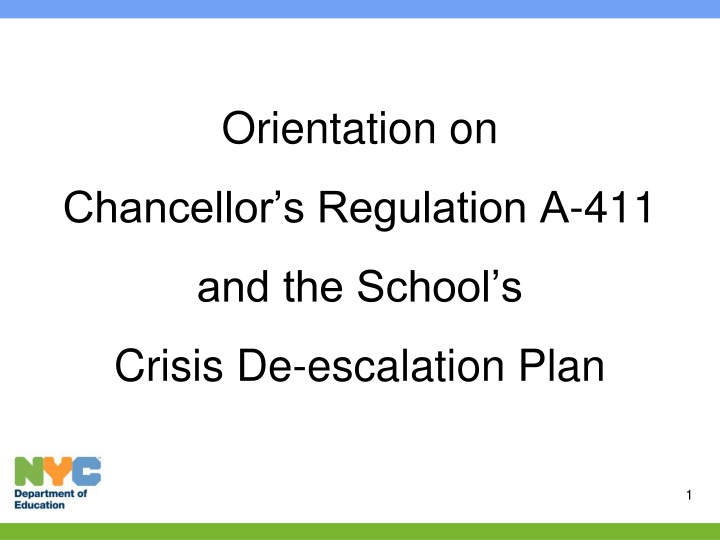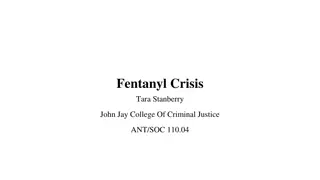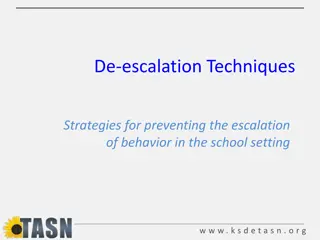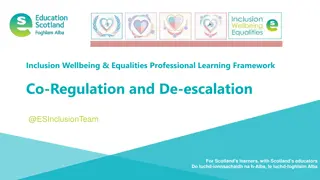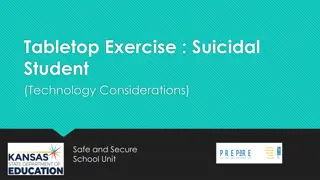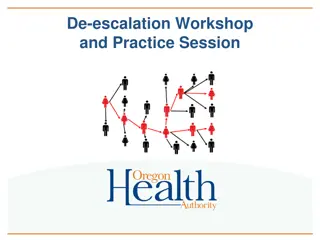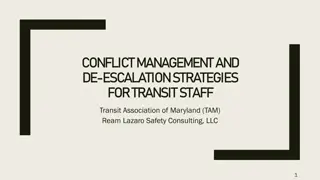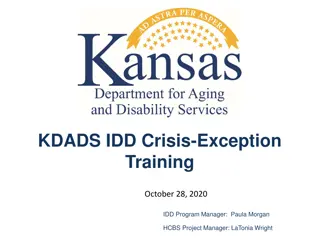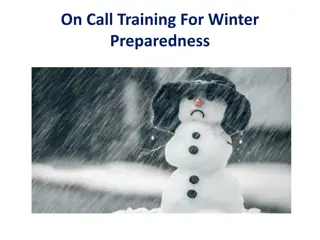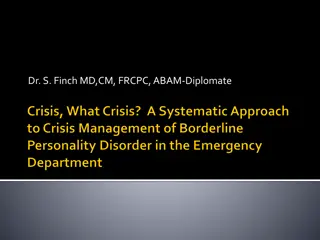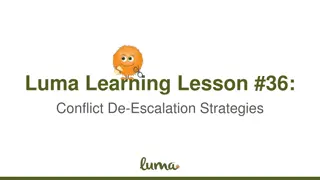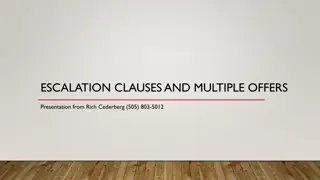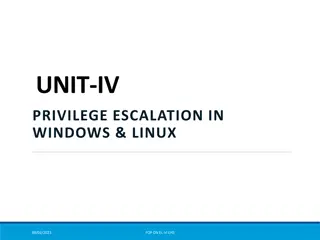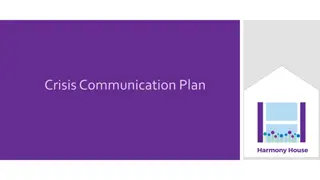School Crisis De-escalation Strategies and Plans
Schools in New York City are committed to maintaining safe and orderly environments for effective teaching and learning. Establishing Crisis Intervention Teams and completing Crisis De-escalation Plans are essential. De-escalation strategies involve identifying crises, assessing strengths and weaknesses, addressing student needs, considering environmental factors, developing intervention plans, and reducing risk of harm. Supporting students in behavioral crises is crucial for ensuring safety and facilitating a return to normalcy.
Download Presentation

Please find below an Image/Link to download the presentation.
The content on the website is provided AS IS for your information and personal use only. It may not be sold, licensed, or shared on other websites without obtaining consent from the author.If you encounter any issues during the download, it is possible that the publisher has removed the file from their server.
You are allowed to download the files provided on this website for personal or commercial use, subject to the condition that they are used lawfully. All files are the property of their respective owners.
The content on the website is provided AS IS for your information and personal use only. It may not be sold, licensed, or shared on other websites without obtaining consent from the author.
E N D
Presentation Transcript
Orientation on Chancellor s Regulation A-411 and the School s Crisis De-escalation Plan 1
School School- -wide Expectations wide Expectations The New York City Department of Education is committed to ensuring that our schools are safe, secure, and orderly environments in which teaching and learning take place each day. A safe and supportive school depends on the efforts of all members of the school community members of the school community teachers, students, administrators, parents, counselors, socials workers, safety personnel, related service providers, cafeteria workers, custodians, and bus staff to treat one another with mutual respect. on the efforts of all 2
School School- -wide Expectations (continued) wide Expectations (continued) A Crisis Intervention Team Crisis Intervention Team must be established in every school. The Crisis Team is a multidisciplinary team which may include the school principal, guidance counselors, teachers, social workers, school based support team members and other staff members who have an understanding and working knowledge of crisis issues. The team is responsible for helping schools respond to, manage and de-escalate school-wide and student crises. 3
School School- -wide Expectations (continued) wide Expectations (continued) Each school s Crisis Intervention Team must complete a Crisis De escalation Plan escalation Plan as part of its Consolidated Youth Development Plan. Crisis De- - The plan must be submitted to the FSC for review by September 30 The plan must be submitted to the FSC for review by September 30th th. . De-Escalation Plans will be reviewed by the Crisis/De-Escalation Managers at the Borough Field Support Centers, and feedback will be provided in order for schools to finalize their plans by October 31st. A copy of Chancellor s Regulation A-411 must be made available to parents upon request. 4
What does De What does De- -escalation involve? escalation involve? De-Escalation involves: identifying a potential crisis; assessing the situation in terms of personal strengths and weaknesses; identifying the student s needs; identifying environmental factors; developing an intervention strategy; and applying an intervention that decreases risk of harm. 5
Supporting Students in Behavioral Crisis Supporting Students in Behavioral Crisis Schools must be prepared to manage student behavior in the event of a behavioral crisis to ensure the safety of all students and staff. In order to provide the student in crisis with the necessary supports and to enable the student and staff to return to their routine and schedule, schools are encouraged to utilize support techniques and strategies, such as the ones taught in Therapeutic Crisis Intervention for Schools (TCIS) and Life Space Crisis Intervention (LSCI). 6
School Responsibilities under School Responsibilities under Chancellor s Regulation A Chancellor s Regulation A- -411 411 The following slides will provide an overview of the regulation. For more information see Chancellor s Regulation A-411. This Regulation establishes the Department of Education s ( DOE ) policy and procedures regarding intervention and de-escalation, and contacting 911 for students experiencing behavioral crises. When a student engages in behavior that poses a substantial risk of serious injury to the student or others, schools must determine the appropriate way to manage the behavior and consider whether the situation can be safely de-escalated by school staff. In such situations the following procedures must be followed. 7
De De- -Escalation Procedures Escalation Procedures In situations where the student engages in behavior that poses a substantial risk of serious injury to the student or others, the following procedures must be followed: The principal/designee must be notified of the situation and must attempt to reach the parent. The parent must be given an opportunity to speak by telephone or in person with his/her child where safety considerations permit and where it will not interfere with school staff s efforts to de-escalate the situation. Every effort must be made by responding school staff to safely de-escalate the behavior where possible using: Strategies and interventions for addressing behavioral crises; and The in-school and community resources identified in the school s Crisis De-escalation Plan. 8
De De- -Escalation Procedures (cont.) Escalation Procedures (cont.) If the classroom teacher or the responding staff member is unable to de- escalate the behavior, the teacher/staff member should seek assistance from staff members trained in crisis de-escalation. The teacher/staff member may also seek assistance from other appropriate staff and resources including: The assistant principal; A dean; A member of the school s Crisis Intervention Team; A member of the Building Response Team; A guidance counselor; School-Based Mental Health Clinic (SBMH) or a School-Based Health Center with mental health services (SBHC) if there is one on-site; and/or The Children s Mobile Crisis Team, if available in the borough. 9
Calling 911 Calling 911 However, where a student s behavior poses an imminent and substantial risk of serious injury to himself or others and the situation cannot be safely addressed by school staff or the support services set forth above, the principal/designee must call 911. In situations where it is not practicable to contact the principal/designee, the responding staff member/School Safety Agent must call 911 and immediately thereafter notify the principal/designee. 10
Schools Responsibilities Schools Responsibilities When 911 is Contacted When 911 is Contacted When 911 is called for a student, the principal/designee must immediately attempt to reach the parent to notify him/her that 911 was called. The parent must be given an opportunity to speak to the on- scene 911 responders and the student in person or by phone if it is feasible and it will not interfere with the proper discharge of the on-scene 911 responders duties and responsibilities. 11
Schools Responsibilities When 911 is Schools Responsibilities When 911 is Contacted Contacted If the parent has not arrived at the school but has been reached by phone, the parent must be given an opportunity to speak to the on-scene 911 responders and the student if it is feasible and it will not interfere with the proper discharge of the on-scene 911 responders duties and responsibilities. If the parent requests that his or her child not be transported to the hospital, the on-scene responders will obtain relevant information from DOE staff, the parent and others as appropriate and determine whether the parents request may be honored. 12
Reporting Procedures Reporting Procedures The principal/designee must notify the DOE s Emergency Intake Center (EIC) at DOE s Emergency Intake Center (EIC) at (718) 935 (718) 935- -3210 3210 whenever 911 has been contacted. The principal/designee must file an Online Occurrence Report (OORS Report) Online Occurrence Report (OORS Report) within 24 hours of the incident for all school-related incidents, including all incidents for which 911 was contacted. The Office of Safety and Youth Development (OSYD) provides a help desk to assist with any technical questions regarding the filing of an OORS report. The help desk is available from 8:00 am to 5:00 pm Monday through Friday. To contact the help desk, call (718) 935-5004 and ask for the OSYD Web Support. Upon request, parents have the right to receive a copy of their child s occurrence report. In accordance with Chancellor s Regulation A-820 and the Family Educational Rights and Privacy Act (FERPA), student names and other personally identifiable information about other students must be redacted from the report. 13
Additional Considerations and Follow Additional Considerations and Follow- -Up Measures Measures 911 should not be called in response to a behavioral crises unless the student s behavior poses an imminent and substantial risk of serious injury to the student and/or others and cannot be safely de-escalated using de-escalation strategies and/or school and community resources Up 911 should not be called or employed as a disciplinary measure or as disciplinary response to a student s behavior Schools may not request or require a mental health clearance letter as a condition to a student attending or returning to school. Where appropriate, school staff should meet with the parent and student who has been in crisis to discuss and implement positive behavior supports and intervention plans for the student. 14
Crisis De Crisis De- -Escalation Plan Escalation Plan Each school s Crisis Intervention Team must complete a Crisis De Each school s Crisis Intervention Team must complete a Crisis De- -escalation Plan as part of its Consolidated School and Youth Development Plan. Such plan must: as part of its Consolidated School and Youth Development Plan. Such plan must: escalation Plan include strategies for de-escalating behavioral crisis situations; identify locations in the school building in which students in crisis may be safely isolated from others; identify any school staff trained in de-escalation techniques; identify in-school and community resources that are available to the school and parents (e.g., mental health clinics, mobile crisis teams, facilities that provide urgent/same-day mental health assessments); and describe how crisis de-escalation and response protocols are communicated to school staff. 15
School Specific Plan The following slides provide information about your school s De-escalation Plan Adapt based on the answers to your plan 20
Strategies and Protocols to De Strategies and Protocols to De- -Escalate Behavioral Crises Behavioral Crises Escalate Our school implements the following school-wide strategies and approaches to create a supportive school environment: (School inserts details from the plan) 21
Strategies and Protocols to De Strategies and Protocols to De- -Escalate Behavioral Crises (cont.) Behavioral Crises (cont.) Escalate Our school uses the following intervention measures to respond to student behavioral issues: (School inserts details from the plan) 22
Strategies and Protocols to De Strategies and Protocols to De- - Escalate Behavioral Crises (cont.) Escalate Behavioral Crises (cont.) Our school uses the following strategies and protocols to de-escalate a student in a behavioral crisis: (School inserts details from the plan) 23
Staff members trained in Life Space Crisis Staff members trained in Life Space Crisis Intervention, Therapeutic Crisis Intervention, Intervention, Therapeutic Crisis Intervention, and other De and other De- -Escalation Techniques Escalation Techniques The following staff members are trained in LSCI: (School inserts details from the plan) The following staff members are trained in TCIS: (School inserts details from the plan) The following staff members are trained in the following other De-Escalation techniques: (School inserts details from the plan) 24
Indicate the support location(s) in the school Indicate the support location(s) in the school building where students in crisis may be taken building where students in crisis may be taken Specific areas or rooms where students in crisis may be taken are: (School inserts details from the plan) This room is available at the following times of day: (School inserts details from the plan) DOE staff responsible for escorting the students to these rooms/areas: (School inserts details from the plan) 25
Indicate the support locations in the school building where other Indicate the support locations in the school building where other students may be taken in the event the student in crisis cannot or students may be taken in the event the student in crisis cannot or should not be brought to a different location should not be brought to a different location Specific areas or rooms where other students may be taken if necessary are: (School inserts details from the plan) This room is available at the following times of day: (School inserts details from the plan) DOE staff responsible for escorting the students to designated room/area: (School inserts details from the plan) 26
School and Community Resources School and Community Resources The following in-school and community resources are available to the school and parents for supporting students dealing with behavioral issues and crises: (School inserts details from the plan) 27
Discussion Discussion Think of a behavioral crisis to which you responded during the school year. What went well? Which aspects of the behavioral crisis intervention were most challenging for you? What might you do differently next time? What additional support(s) could have been helpful to you? 28
Crisis/De Crisis/De- -Escalation Mangers at the Field Escalation Mangers at the Field Support Center Support Center (Just include your FSC) (Just include your FSC) Affinity Group Affinity Group Gerry Menegatos Gerry Menegatos GMenega@schools.nyc.gov GMenega@schools.nyc.gov Brooklyn North: Districts 13, 14, 15, 16, 19, 23, 32 Brooklyn North: Districts 13, 14, 15, 16, 19, 23, 32 Helene Moffatt Helene Moffatt HMoffatt@schools.nyc.gov HMoffatt@schools.nyc.gov Brooklyn South: Districts 17, 18, 20, 21, 22 Brooklyn South: Districts 17, 18, 20, 21, 22 Janine Dasilva Janine Dasilva JDasilva3@schools.nyc.gov JDasilva3@schools.nyc.gov Bronx: Districts 7, 8, 9, 10, 11, 12 Bronx: Districts 7, 8, 9, 10, 11, 12 Tyrone Belthrop Tyrone Belthrop TBelthr@schools.nyc.gov TBelthr@schools.nyc.gov 29
Crisis/De Crisis/De- -Escalation Managers at the Escalation Managers at the Field Support Centers Field Support Centers (Just include your FSC) (Just include your FSC) Manhattan: Districts 1, 2, 3, 4, 5, 6 Manhattan: Districts 1, 2, 3, 4, 5, 6 Dana White Dana White DWhite5@schools.nyc.gov DWhite5@schools.nyc.gov Staten Island: District 31 Staten Island: District 31 Ross (Alan) Lewin Ross (Alan) Lewin RLewin@schools.nyc.gov RLewin@schools.nyc.gov Queens North: Districts 24, 25, 26, 30 Queens North: Districts 24, 25, 26, 30 Donna Brailsford Donna Brailsford DBrails@schools.nyc.gov DBrails@schools.nyc.gov Queens South: Districts 27, 28, 29 Queens South: Districts 27, 28, 29 Myra Lasalle Kaplan Myra Lasalle Kaplan MLasall3@schools.nyc.gov MLasall3@schools.nyc.gov 30
Crisis/De Crisis/De- -Escalation Support for Escalation Support for District 75 District 75 (Delete if you are not a District 75 School) (Delete if you are not a District 75 School) Roslyn Hoff RHoff2@schools.nyc.gov Natasha Davidson NDavidson2@schools.nyc.gov Glazen Celerio GCelerio@schools.nyc.gov 31
